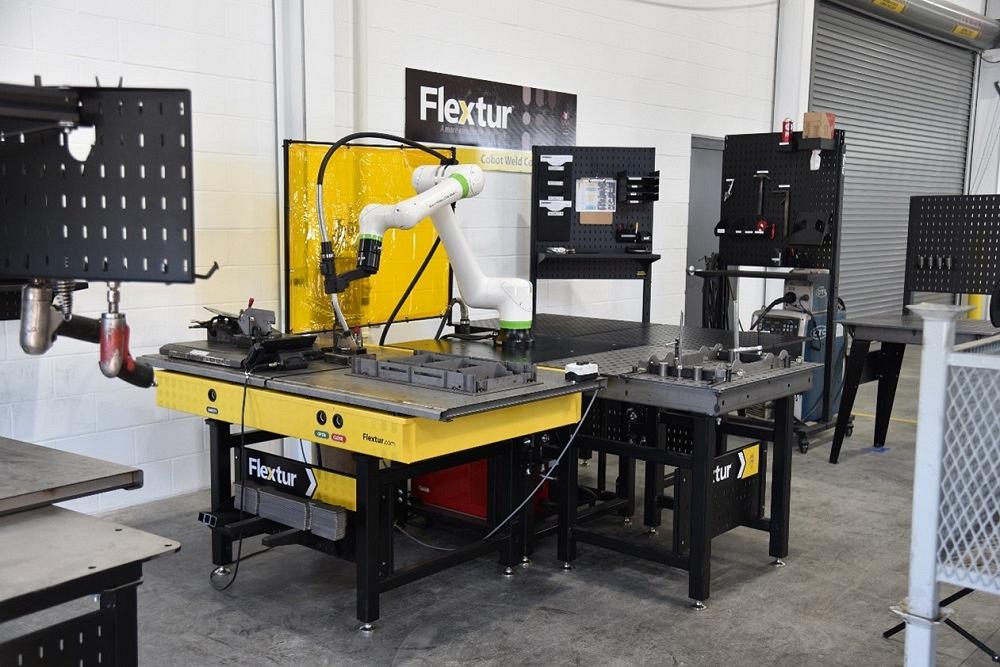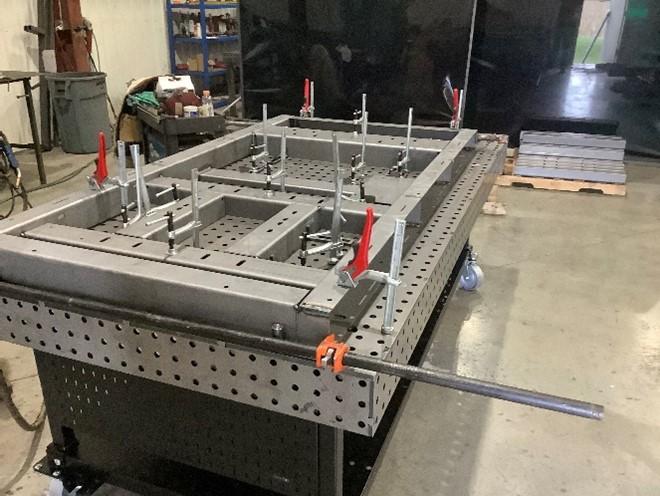Vice President of New Product Development
- FMA
- The Fabricator
- FABTECH
- Canadian Metalworking
Categories
- Additive Manufacturing
- Aluminum Welding
- Arc Welding
- Assembly and Joining
- Automation and Robotics
- Bending and Forming
- Consumables
- Cutting and Weld Prep
- Electric Vehicles
- En Español
- Finishing
- Hydroforming
- Laser Cutting
- Laser Welding
- Machining
- Manufacturing Software
- Materials Handling
- Metals/Materials
- Oxyfuel Cutting
- Plasma Cutting
- Power Tools
- Punching and Other Holemaking
- Roll Forming
- Safety
- Sawing
- Shearing
- Shop Management
- Testing and Measuring
- Tube and Pipe Fabrication
- Tube and Pipe Production
- Waterjet Cutting
Industry Directory
Webcasts
Podcasts
FAB 40
Advertise
Subscribe
Account Login
Search
Reaping the benefits of welding fixtures
Determining the right type of fixture to build, and the right time to build it
- By Doug Scheetz
- September 29, 2023
- Article
- Arc Welding

An overlooked area when building and incorporating fixtures into a workflow is changeover time. This is an important thing to consider when welding with cobots and robots.
It’s no industry secret that welding fixtures improve consistency, optimize quality, and reduce defects. That has never been more important than it is today, especially when considering the skills gap facing the welding industry. Fixtures guide the welding process, minimizing the welder skill level required. This is especially valuable for training new welders and maintaining consistent quality across a team of less-experienced welders.
Before You Build
In a perfect scenario, the concept of a welding fixture would be considered during the design or prototyping of a particular part or product. This allows you to incorporate fixture requirements into the product design and ensure the fixture can hold the components in the correct position for welding.
But this is seldom the case. Nor does the typical RFQ on a contract part come with a note saying, “Be sure to charge us for whatever fixtures you’re going to build.”
Following are five questions to help you determine the right time to build a welding fixture:
- How complex is the project? If your welding project involves complex or intricate components that need precise alignment for welding, it's advisable to start designing a custom fixture to achieve accurate and consistent results.
- What is the current volume, and is this repeat business? If you are planning to produce many identical or similar components, a welding fixture can significantly improve efficiency and consistency in the welding process. The same can be said for repeatable parts, such as seasonal jobs that have lower quantities but repeat year after year.
- Is there a margin in place, or can I charge for the fixture? Building a custom welding fixture involves design, fabrication, and setup costs. Will the potential benefits in terms of efficiency, accuracy, and quality outweigh the initial investment? Or perhaps the customer will pay to offset the cost of the fixture. If this is an option, be sure to clarify who owns the fixture if something in the relationship changes in the future.
- How important are consistency and quality for this part or this customer? If your customer demands high consistency and quality of welds, a fixture ensures that each weld joint is positioned correctly, leading to better overall product quality.
- How experienced is your team? If the welding process is sensitive to the skill and experience of the operator, a fixture can help reduce the dependence on operator skill by providing clear guidelines for alignment and positioning with a solid correlation to quality and consistency.
The Qualities of a Good Welding Fixture
Once you have done your homework and made the decision to proceed with a fixture, it’s equally important to understand the desirable qualities of a good welding fixture. First and foremost are precision and accuracy. A high-quality fixture should provide precise and accurate alignment of the parts, ensuring consistent and accurate welds.
A good fixture often will expose inconsistencies in the parts, especially in automation. It also may reveal the need for tighter tolerances in other processes leading up to welding, such as in in cutting or forming.
In the same manner, a fixture should be designed to provide stable and rigid support to the components being welded. Ideally, you want to achieve this with the fewest number of touch points to the part. Fixtures can better withstand the heat and wear associated with daily use when constructed with durable materials.
Effective clamping mechanisms are often essential for securely holding the components in place. Clamping is especially important when part tolerances vary or when the fixture is used in a rotating headstock or tailstock. These mechanisms should provide sufficient clamping force without deforming the workpieces.
Likewise, clamping mechanisms should allow sufficient access for the welding torch to reach the weld joint, whether welding is manual or automation. Proper clearance ensures that the welder can perform the welding process without having to work around clamps that prevent the optimum welding angle.
Ease of setup is also extremely important. How easy is it to load parts into the fixture? Is the fixture marked clearly or symmetrically designed? Poka-yoke is a Japanese term that describes this process as "mistake-proofing.” In this example, it means there is only one possible way to load the parts. The goal of any poka-yoke design is to make processes more reliable, efficient, and less prone to errors. On the back end of that, how easy is it to remove the completed weldment? For this, you need to consider things like clearance, hoist accessibility, or the ergonomics of smaller parts being handled manually.

Welding fixtures enhance precision and consistency, increase efficiency and productivity, and reduce the dependence on an operator’s skills level.
Another overlooked area when building and incorporating fixtures into a workflow is changeover time. What’s involved in switching to the next fixture? How long does it take to get the last good part out of the current fixture until you get the first good part out of the new fixture? This becomes even more essential with automation, specifically welding with cobots and robots.
A quick-clamp system for fixtures on high-mix/low-volume parts in a traditional robotic setting allows you to switch between fixtures very quickly and extremely accurately with minimal robot downtime.
Consider Fixture Types
With so many ways to create fixtures and levels of complexity, what’s the best way to determine what type of fixture to use? The choice of welding fixture depends on factors such as the welding process, workpiece geometry, production volume, and desired weld quality. For years, fab shops have considered a flat steel table with the ability to clamp along the edge to be good enough. However, today’s manufacturers often require greater accuracy and efficiency to remain competitive. Furthermore, welders with less experience may require more tools to help them become more effective quickly.
Welding table fixturing with pin and clamp capabilities can greatly increase the accuracy and effectiveness of welders of all skill levels, but they are most effective for one-off or very short-run parts for which a fixture isn’t possible or doesn’t make sense based on the considerations noted previously. A good rule of thumb is to start with basic fixturing methods and gradually evolve to more advanced fixtures as you gain experience and understand the specific requirements of your welding process.
Here’s a tip: Always document any configuration you create on a welding table for pin and clamp locations. This can be done with pictures or notes. You just never know when that one-of-one weldment will come back around for a second, third, or nth time.
Typically, the next progression from a welding table is made when a particular part meets the requirements you have determined to merit a fixture investment. Simple welding stops, clamps, and other contact points affixed to a common base constitutes a fixture. This is then typically mounted securely to another table for manual welding applications. This basic type of fixture primarily focuses on holding the workpieces in place securely during welding. This helps keep pieces in place accurately and minimize any warping caused by the welding process. This fixture style can be very basic or extremely complex, depending on your application and experience level.
From this point, using software can increase accuracy and efficiency when creating fixtures. You can draw the fixture around the 3D-rendered part, creating the critical touch and clamp points manually in a CAD program. Or you can use a designated software package to generate the basic fixture in a highly automated way. As you begin to create and use more fixtures, the ROI on these software systems becomes very evident.
In addition, you can incorporate sequential fixtures in a couple of ways. If a weldment needs to be turned or flipped for welding on all sides but does not merit a positioner or head/tailstock-style fixture, a series of more basic fixtures can be created to move a part manually through the sequence. This often is used for cobot applications with limited reach.
What to Expect
Welding fixtures give you greater control over the welding process, leading to improved precision, efficiency, and weld quality. They help minimize errors, enhance repeatability, and contribute to overall process optimization with the following benefits:
- Enhanced precision and consistency - Accuracy leads to consistent weld joint placement and uniform weld quality across multiple pieces. By eliminating variations caused by manual setup, fixtures help reduce the risk of defects and ensure that every weld meets the desired specifications.
- Increased efficiency and productivity - Welding fixtures streamline the setup process by providing a standardized and repeatable method for holding workpieces. Welders can complete more welds in less time while maintaining high quality.
- Reduced dependence on operator skill - Fixtures help minimize the welder skill level required to achieve accurate and consistent welds. Fixtures guide the welding process by providing clear alignment and positioning, reducing the reliance on individual operator skill. This is especially valuable for training new welders and maintaining uniform quality across different operators, shifts, or facilities.
About the Author
About the Publication
subscribe now

The Welder, formerly known as Practical Welding Today, is a showcase of the real people who make the products we use and work with every day. This magazine has served the welding community in North America well for more than 20 years.
start your free subscription- Stay connected from anywhere

Easily access valuable industry resources now with full access to the digital edition of The Fabricator.

Easily access valuable industry resources now with full access to the digital edition of The Welder.

Easily access valuable industry resources now with full access to the digital edition of The Tube and Pipe Journal.
- Podcasting
- Podcast:
- The Fabricator Podcast
- Published:
- 04/16/2024
- Running Time:
- 63:29
In this episode of The Fabricator Podcast, Caleb Chamberlain, co-founder and CEO of OSH Cut, discusses his company’s...
- Trending Articles
Sheffield Forgemasters makes global leap in welding technology

ESAB unveils Texas facility renovation

Engine-driven welding machines include integrated air compressors

How welders can stay safe during grinding

The impact of sine and square waves in aluminum AC welding, Part I

- Industry Events
16th Annual Safety Conference
- April 30 - May 1, 2024
- Elgin,
Pipe and Tube Conference
- May 21 - 22, 2024
- Omaha, NE
World-Class Roll Forming Workshop
- June 5 - 6, 2024
- Louisville, KY
Advanced Laser Application Workshop
- June 25 - 27, 2024
- Novi, MI



























